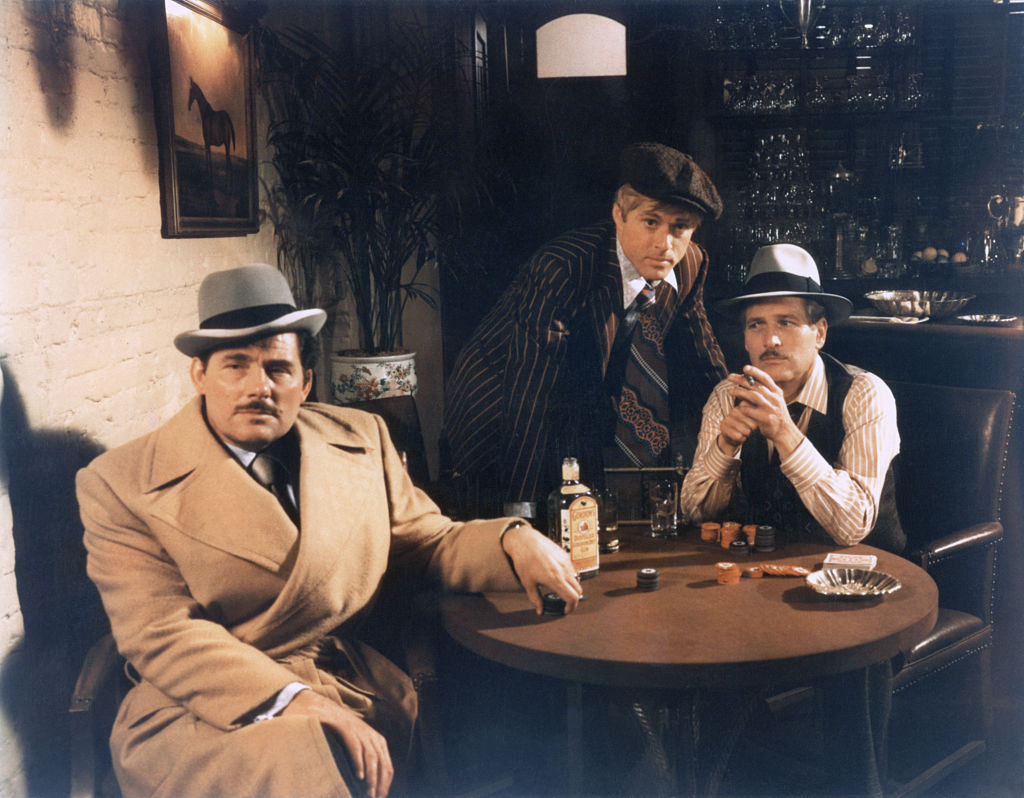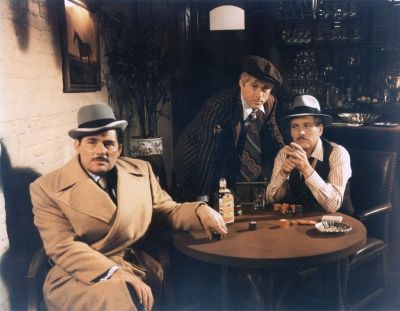When The Sting hit theaters in late 1973, it had all the makings of a major New Hollywood production. Paul Newman and Robert Redford, both stalwarts of the movement, had reunited four years after Butch Cassidy and the Sundance Kid. They had joined forces again with director George Roy Hill, who like Newman and Redford had first gained fame as the Old Hollywood studio system was giving way to a more open playing field. Screenwriter David S. Ward, a self-starting 28-year-old, actually pitched his screenplay to two independent producers outside of the usual hierarchies. By all outward appearances, The Sting fit squarely with the ethos of a nascent era, one not bound by the strictures of the past.
Yet Hill’s film now feels like a fond throwback to an earlier studio era, especially compared to other classics released that year. Unlike Martin Scorsese’s Mean Streets or Robert Altman’s The Long Goodbye, The Sting doesn’t carry the weight of a singular authorial vision. And unlike one of its Oscar rivals for Best Picture, The Exorcist, it doesn’t take advantage of Hollywood’s new liberties to push the envelope on taste or content. The Sting is more breezy than brooding, with its deliberately artificial soundstage sets, title cards, iris shots, and matte paintings hearkening back to Hollywood’s Golden Age.
For a film stacked with New Hollywood talent, The Sting carries a distinctly Old Hollywood sensibility. This sleight of hand, 50 years later, is key to its enduring appeal.
Like any good yarn, The Sting is as simple or complex as you want to tell it. Short version: Redford plays Johnny Hooker, a cocky young hustler in 1936 Chicago who teams up with a washed-up con artist, played by Newman, to take revenge on an Irish mob boss. Long version: Well, it gets complicated. One of the pleasures of the movie is how its simple premise gets entangled in increasingly elaborate schemes and double crosses.
The script helps orient viewers by breaking the film into discrete sections, each corresponding to a stage in a con (“The Hook,” “The Set-Up”) and demarcated by hand-painted title cards. This structural conceit both implicates viewers in the characters’ “big con” and consciously recalls the conventions of silent cinema.
Its score also fashions an out-of-time quality. From the opening credits, the movie is inseparable from the classic piano rags of Scott Joplin, as adapted by composer Marvin Hamlisch. Yet Joplin’s ragtime dates to the turn of the century, not the 1936 of the film’s setting. No matter: Hill and Hamlisch stuck to their guns, despite producers’ complaints about the anachronism, and audiences rewarded them by sending the King of Ragtime to the top of the charts in 1974.
The Sting is full of similar choices, seemingly inevitable now but counterintuitive then. Consider the casting. One might assume that the movie was conceived as a Newman-Redford vehicle, given their obvious chemistry and past success on Butch Cassidy. But The Sting was initially planned with just Redford in mind; Newman came on board later and had reservations about playing the washed-up older confidence man. In her pan for The New Yorker, Pauline Kael agreed with Newman’s doubts. “Isn’t it a little early in life for Paul Newman to be playing an old-pro trickster coming out of retirement for one last score?” Kael wrote.
What Kael missed, but the filmmakers understood, was that authentic charisma carries more weight than mere realism. Newman was only 11 years older than Redford, but was a wizened pro in comparison, someone who had already endured several ebbs and flows in his box office fortunes and turbulent home life. And in true Method acting fashion, Newman channeled some of that personal history through his character.
When we first meet Henry Gondorff, he is recovering from a major bender and, to fast-track his recovery, cuts up an ice block in the sink to dunk his face in the water. Newman plays the scene methodically, as if it’s a regular habit for his character. According to Newman’s own children, this was a case of art imitating life. Himself a high-functioning alcoholic, Newman brought his preferred morning hangover recovery to the set as an improvised bit of stage business, which the filmmakers happily embraced.
Later, in one of The Sting’s most memorable scenes, a sober Gondorff plays drunk at a poker game to antagonize his mark, the crusty Irish gangster Doyle Lonnegan (Robert Shaw). It’s a superb bit of scene-stealing from Newman—swilling gin, sneezing into his tie, guffawing with glee at every stroke of manufactured luck—fitting for a star who seemed impossibly charmed on screen while drinking away his troubles at home.
Indeed, The Sting works so well because it is attuned to the life experiences and particular qualities of its actors. In one crucial role, playing a seasoned grifter who mentors Redford’s novice, Hill cast Robert Earl Jones—a legend of the Harlem Renaissance who had climbed his way from rural black poverty in Mississippi to actorly and athletic fame in the 1930s. In his limited runtime, Jones conveys a jaded authority and wisdom that cannot be faked.
The female lead, Eileen Brennan, doesn’t have the appearance of a conventional starlet, but instead brings the acerbic, world-weary wit of a Bette Davis or Joan Crawford. Similarly, Hill cast the unknown Dimitra Arliss in another femme fatale role, despite studio complaints that she was not pretty enough to seduce Robert Redford. Hill stuck to his choice and defended her to the hilt, just as he insisted that Robert Shaw was the right choice for the villain despite a pre-production injury that threatened to sideline the actor.
George Roy Hill, alas, is not much remembered today. In a 2004 featurette recalling the film’s making, its cast fondly refers to him as a “craftsman” and an “actor’s director.” That might sound like damning with faint praise, but Hill’s contribution should not be underestimated: The film comes off seamlessly because of him. Like a good confidence man—or a classic studio director—Hill keeps all his balls in the air and the audience’s focus on the action before them, serving the story and not himself.
One can even see in the movie’s climax a hint of Hill’s communal approach to moviemaking. To pull off their “big con,” Gondorff and Hooker have to construct an elaborate alternate reality—building a massive set to simulate a betting parlor, hiring a large cast of committed bit players, and enlisting a behind-the-scenes narrator reading phony racetrack updates to a captive audience. It’s a vision of con artistry as a collective enterprise, which is not far off, intentionally or not, from the old Hollywood studio system. In a movie as expertly entertaining as The Sting, we viewers don’t mind being the marks.
What’s the enduring legacy of The Sting? With the benefit of hindsight, its Oscar sweep—seven total, including Best Picture and Director—seems like a triumph of popular appeal over artistry. Did Hill really deserve to win against a stacked field that included William Friedkin, George Lucas, Ingmar Bergman, and Bernardo Bertolucci? Was The Sting even the best crime drama to hit American screens in 1973, let alone the Best Picture of the year? In a year that also saw the release of Mean Streets, The Long Goodbye, Serpico, and The Friends of Eddie Coyle, it’s a debatable proposition.
But such apples-and-oranges comparisons elide the merits of the film itself. The Sting may seem slight compared to The Exorcist or Cries and Whispers, but it endures as both impeccable entertainment and as a type of movie that’s all too rare these days. It’s a movie with a sharp script unbeholden to pre-existing IP, and which appeals to both Oscar voters and the public without carrying the political baggage that burdens so many of today’s winners.
Pulling off that formula was no cheap trick in 1973; today, such films are virtually an endangered species. All the more reason, then, to celebrate the big con of a crowd-pleaser that hasn’t lost its ability to charm.






Please note that we at The Dispatch hold ourselves, our work, and our commenters to a higher standard than other places on the internet. We welcome comments that foster genuine debate or discussion—including comments critical of us or our work—but responses that include ad hominem attacks on fellow Dispatch members or are intended to stoke fear and anger may be moderated.
With your membership, you only have the ability to comment on The Morning Dispatch articles. Consider upgrading to join the conversation everywhere.